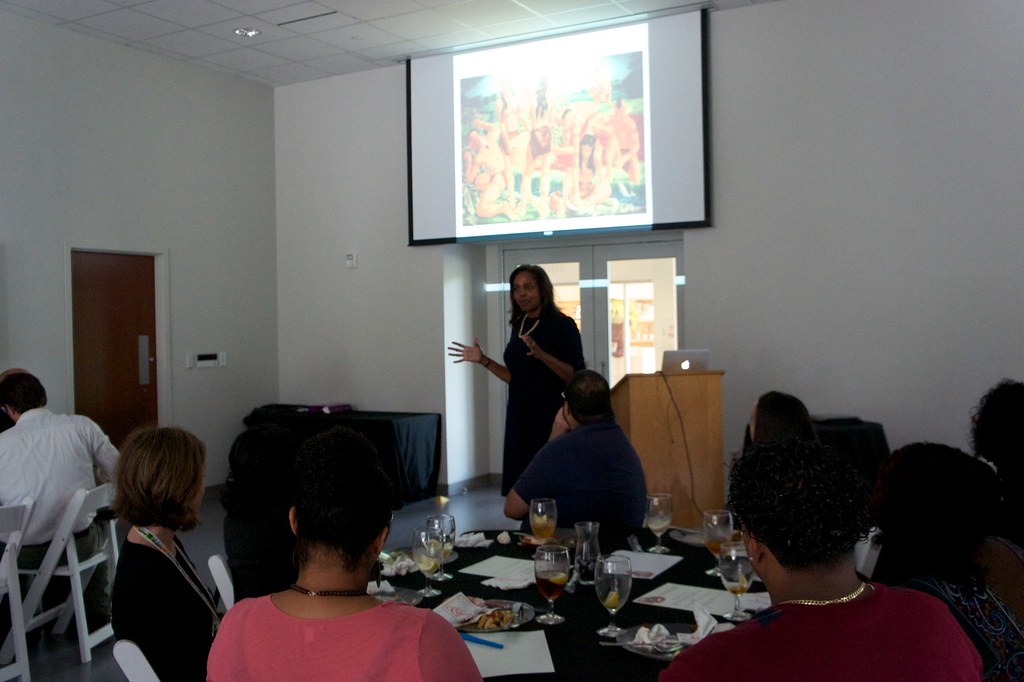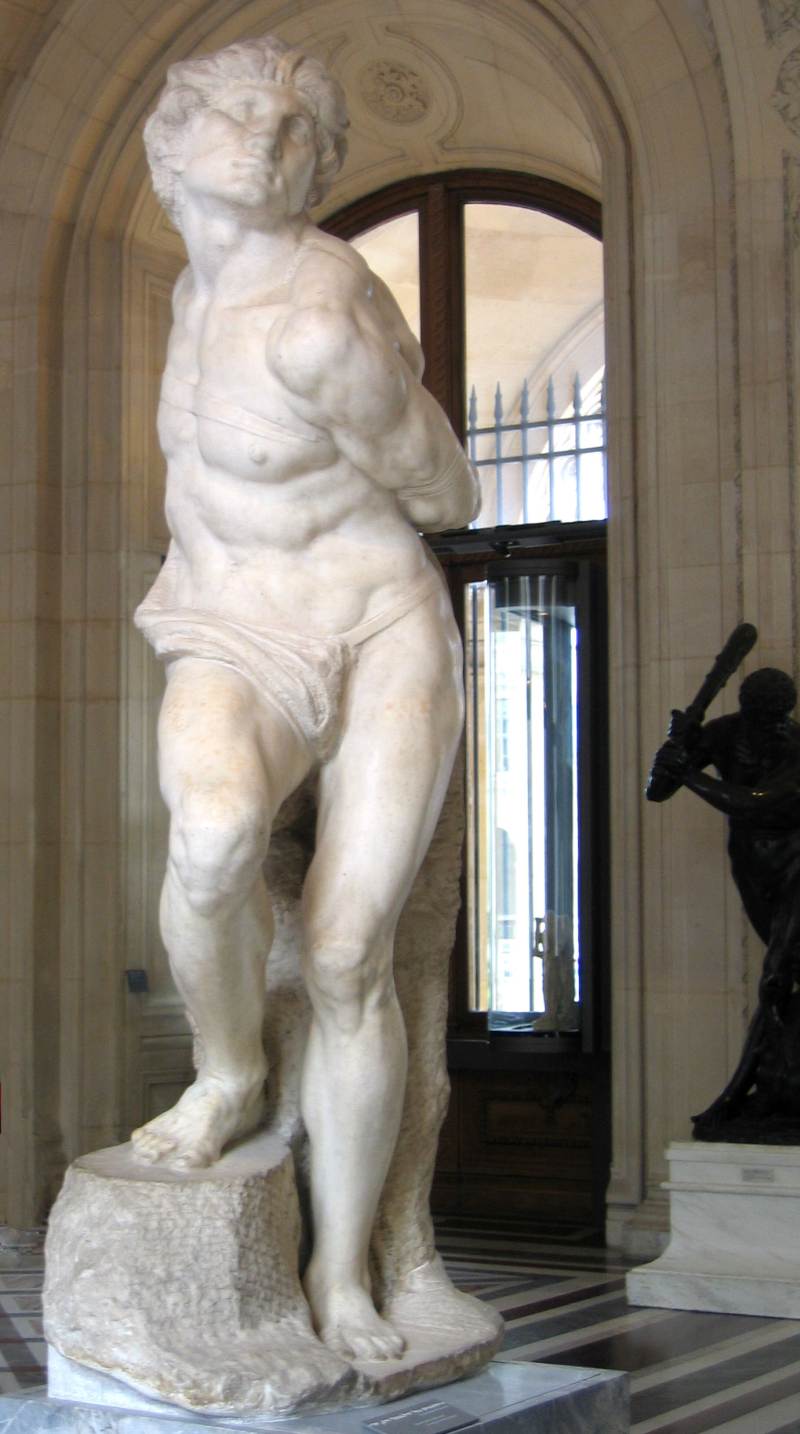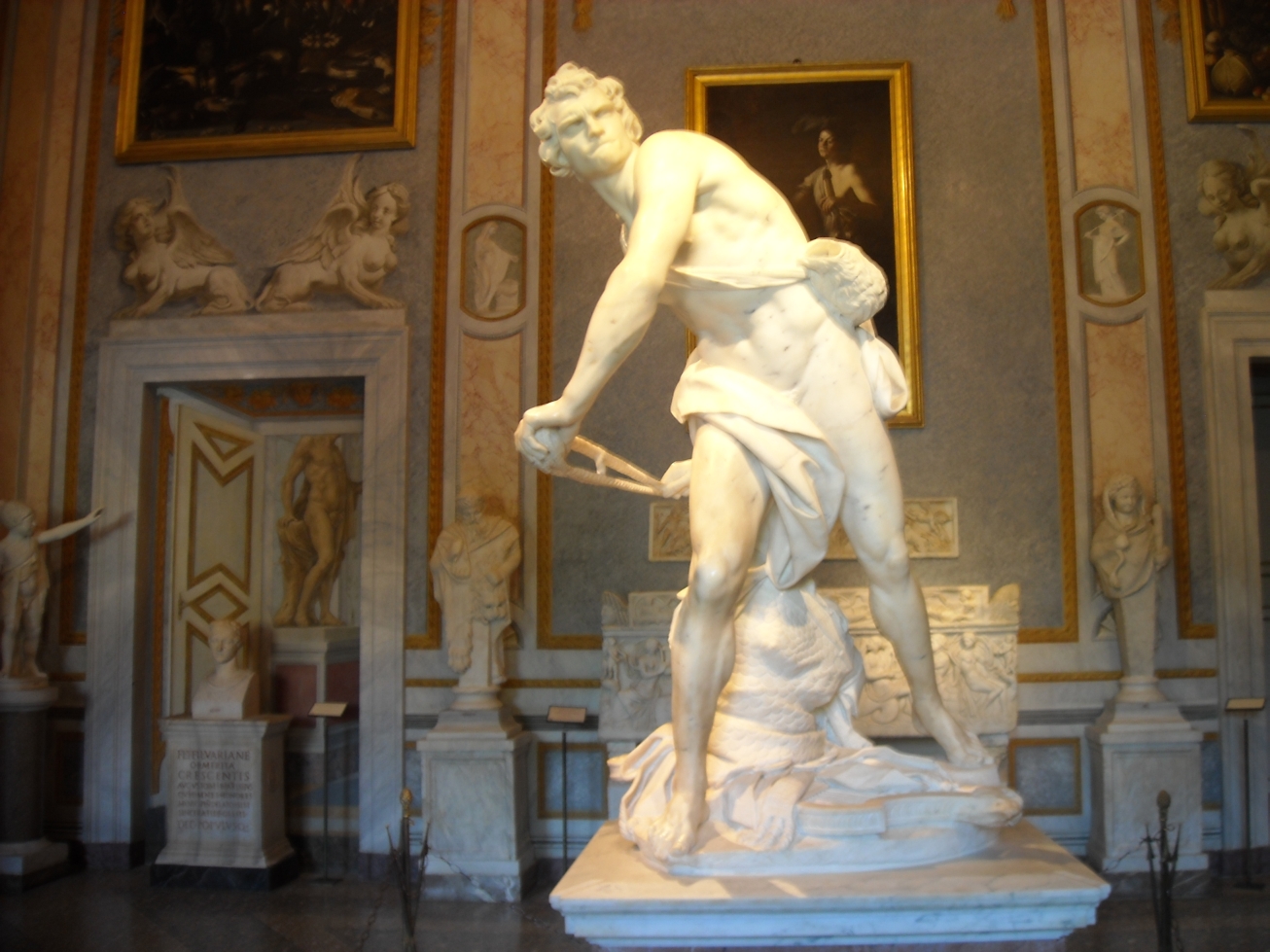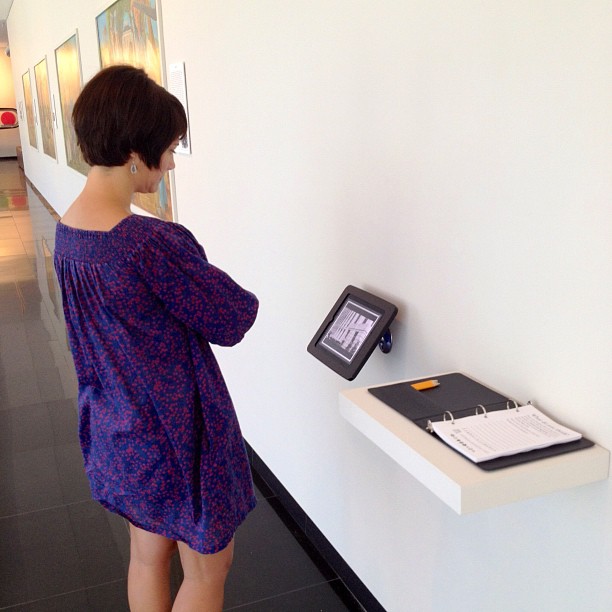Joe Kovac Jr. on "The art and the cover-up: Renowned artist's history of Macon mural hidden."

The Georgia Museum of Art, University of Georgia, displays four murals painted by George Beattie in 1956 and removed from the Georgia Department of Agriculture’s building in Atlanta in 2011. The four oil paintings on Masonite, on exhibition from Aug. 1, 2012, to Jan. 7, 2013, address the state’s history of agriculture and feature American Indians, the founding of Georgia, and the role of enslaved persons in sugar and cotton production.
Sunday, March 31, 2013
Monday, October 29, 2012
Tuesday, October 23, 2012
Dialogues in Diversity photographs
Two images from Friday, October 12, and the discussion of what George Beattie's
agriculture murals portray,
how they portray it, and why they are
controversial. (With Valerie Babb,
director of the Institute for African
American Studies, and yours truly.) The event was co-sponsored by
the Office of Institutional Diversity in
conjunction with our Education
Department.
Full image set via the museum's flickr page [here].
Full image set via the museum's flickr page [here].
Thursday, September 27, 2012
Wednesday, September 26, 2012
NY Times on Sapelo Island's Geechees
An excerpt from The New York Times, published yesterday, on "Taxes Threaten an Island Culture in Georgia":
Sapelo Island, a tangle of salt marsh and sand reachable only by boat, holds the largest community of people who identify themselves as saltwater Geechees. Sometimes called the Gullahs, they have inhabited the nation’s southeast coast for more than two centuries. Theirs is one of the most fragile cultures in America. These Creole-speaking descendants of slaves have long held their land as a touchstone, fighting the kind of development that turned Hilton Head and St. Simons Islands into vacation destinations.
Tuesday, September 25, 2012
Thursday, August 30, 2012
Wednesday Tour at 2
Proof that it happened yesterday.
A very nice group that included George Beattie III and an entire First Year Odyssey class.
A very nice group that included George Beattie III and an entire First Year Odyssey class.
Monday, August 27, 2012
Thursday, August 23, 2012
Monday, August 20, 2012
A Talk with Tim Frilingos
 |
| Georgia Department of Agriculture exterior |
Tim Frilingos is the director of the Georgia Capitol Museum, which recently became part
of the University of Georgia Libraries. He was intimately involved in the
removal of George Beattie’s murals from the Georgia Department of Agriculture
and in their transfer to the Georgia Museum of Art. The Capitol Museum focuses
on the history of the Georgia Capitol, although Frilingos says part of the
reason it was moved under the University System of Georgia is because there are
still hopes of a Georgia history museum.
Frilingos said that, a few years ago, in 2009, he received a
phone call from Donna Williams Lewis, a reporter at the Atlanta Journal-Constitution who had gone into the Georgia Department of Agriculture building and was “aghast at what she saw.” At that point, he hadn’t yet seen the murals,
especially as his museum “really focuses on the capitol,” so he walked over to
the building to take a look. Frilingos didn’t really see them as offensive,
especially as someone with “an affinity for WPA murals,” and after some
research his opinion was confirmed. “They seemed pretty enlightened compared to
what other people were saying in the era,” he said.
At that time, Arty Schronce, director of public affairs for
the Agriculture Department, contacted Frilingos. Schronce’s department then
prepared a handout that was distributed to members of the public. The handout
focused on the history of Georgia agriculture and how the murals portrayed it.
After Lewis’s article ran,
Frilingos said, “I hadn’t really heard anything about it until January 2011,
when I got a call from the Georgia Building Authority [GBA] that they wanted to
remove the murals. They are very leary of trying to remove any art themselves,
especially since the renovation of the capitol, so they contact[ed] my office. We
went to a meeting with the agriculture commissioner [Gary Black], and I thought
we were going to discuss why it wasn’t a good idea to remove them.” Frilingos
said that he went through his notes from talking to Lewis, to be prepared, but
“It was very clear [in the meeting] that they weren’t going to stay up. So we
had to start thinking about how to do it properly.”
He added, “I was never very clear on why [Black] didn’t want
them. I don’t know if he really felt they were offensive or not. We were told
they were going to put other things in there, but they haven’t yet.”
The murals were framed with metal frames holding them onto
the wall, and it appeared to Frilingos and his staff that some of them seemed
loose from the wall so that if you took the frame off they would fall, an
impression they soon discovered was incorrect.
Frilingos pointed out that neither GBA nor his office was
qualified to remove the murals. “It needed a conservator. They needed some
care.” He also mentioned that “When something’s painted for a building, the
preservationist in me says keep it there. We kept hoping they would, but they
didn’t.”
After hiring the conservator, they discovered that even the
murals that seemed loose from the wall were still affixed with glue. Frilingos
said, “We had to use a wire to get back behind them and separate from the wall.
The one that remains was not necessarily supposed to stay there, but we haven’t
been able to take it down [without damaging it].” He said that if the building
were ever to undergo extensive renovation, it would be more possible to remove
the mural, but short of that, it would be very difficult.
As removing the murals was the plan, Frilingos and David
Carmichael, director of the Georgia Archives, tried to decide what to do with
them. Frilingos said, “I thought if we got them, maybe we could develop some
kind of touring exposition, so we sent it out to every art museum we could
think of in Georgia, and the Georgia Museum of Art contacted me the next day.”
Other groups were interested, but with the reorganization of the Capitol Museum
under the University of Georgia, it was “a much cleaner transfer” to move the
murals to GMOA’s collection.
When asked what other public art exists at the capitol,
Frilingos said there isn’t much. The GBA maintains sculptures, some of which
are on the grounds, and the capitol museum maintains the portraits that exist. Apparently,
the original plan for the capitol building included murals, “but those plans
were nixed for budget reasons.” Some relief sculpture (click here and here to see images of it) exists on the exterior of
the agriculture building,
but on the whole there is little public art in the area.
We appreciate Frilingos' insight and his talking to us about his perspective on the removal of the murals.
Wednesday, August 15, 2012
"Flagpole" article
From today's Athens Flagpole:
Slaves and Squaws
Controversial Murals Go Up at GMOA
1950s murals showing a potentially offensive version of
agricultural life are now on display—in context—at the Georgia Museum of
Art.
By Blake Aued
Wednesday, August 15, 2012
If you believe George Beattie, Georgia used to be full of sexy Native Americans and happy, healthy slaves. Eight of Beatties' murals depicting the history of farming in Georgia adorned the walls of the state Department of Agriculture for more than 50 years, until newly elected Agriculture Commissioner Gary Black ordered them taken down in 2010 for being offensive. Last week, four of the murals dealing with the late-18th and early-19th centuries went back up at the Georgia Museum of Art.
What may have been offensive to someone with business in a government office becomes thought-provoking in a museum, says curator Paul Manoguerra. "I think people are used to thinking about art in a political context, in a historical context, at an art museum," he says.
Beattie painted the murals in 1956, when most whites' attitudes towards and beliefs about minorities were far different than today. Even including American Indians as a part of history was a progressive stance back then, says Communications Director Hillary Brown, who moonlights as a food writer at Flagpole. But the half-dressed, buxom women and muscular men in the painting conform to the outdated ideal of the noble savage. Everything about the painting is wrong, Brown says. "Down to the hairstyles, the clothing, it's just not accurate," she says.
Another mural depicts colonial founder James Oglethorpe and others planting crops while the Native Americans peacefully recede into the background, when, in reality, Creeks fought the European settlers tooth and nail for decades. Two other murals depict idyllic visions of slavery where African Americans work while their white masters look on. "No one's being whipped or in shackles, but it's fairly clear who's doing the labor here," Brown says.
The murals are notable for what they leave out, as well. Sharecropping is skipped over entirely. Another set of four less-controversial paintings deal with the 20th century, depicting life on a farm in the 1950s, a farmers market, a veterinary lab and soil conservation. Brown says she isn't sure whether the museum will put those on display.
Black picked up on the historical inaccuracies shortly before replacing Tommy Irvin, who held the office for more than 40 years. "I don't think they depict what Georgia's all about today," he says. "There's a couple of pictures there that are just not acceptable today."
After having the murals removed in 2011, Black placed them in storage under the supervision of the state capitol museum, a division of the University of Georgia library system. The library then transferred ownership to the Georgia Museum of Art, also a branch of UGA, Manoguerra says. No money changed hands.
The exhibit, which runs through Jan. 7, includes videos of UGA history professor Jim Cobb, Laura Weaver of the Institute of Native American Studies and Valerie Blabb, who teaches about race and gender in the English department. They're also available at YouTube.com/GMOAthens. Visitors can leave feedback in a notebook at the museum or on a Twitter feed dedicated to the exhibit. Museum officials are also planning a luncheon centered around the exhibit with the university's diversity office and a special tour sometime this fall.
In addition to their historical value, Beattie's art is worth showing in its own right, Manoguerra says. His figures, with their sturdy bodies and vague faces, show a strong Regionalist influence similar to Thomas Hart Benton, although Benton was a political leftist who never glossed over the racism and class differences in American society. Beattie worked in a tradition of wall paintings dating back to the Baroque period of the 1600s and quoted a Michaelangelo sculpture in one of his slave murals. "I think they're pretty well executed in terms of aesthetics," Manoguerra says.
Wednesday, August 8, 2012
Monday, August 6, 2012
Athens Banner-Herald article
From Sunday's Athens Banner-Herald:
Controversial murals find new home, and context, at art museum
By Andre Gallant updated Saturday, August 4, 2012 - 5:17pm
For 55 years, a series of murals painted by Atlanta artist Georgie Beattie depicting Georgia’s agricultural history hung in the state’s Department of Agriculture building.
Framed into marble walls, idealized images of Native Americans harvesting corn and slaves working cotton through a gin drew scattershot complaints during their tenure in the Atlanta ag offices. But in 2010, when a new agriculutural commissioner took office after a 41-year run by his predecessor, the incoming boss decided they needed to go.
“I don’t like those pictures,” agricultural commissioner Gary Black, who ordered their removal, said at the time. “I think we can depict a better picture of agriculture.”
As of Aug. 1, the Beattie murals will hang prominently at the Georgia Museum of Art.
In a news release, museum officials said they felt it important to preserve “this aspect of Georgia’s history.”
“There are not that many opportunities to acquire and to study beautiful, large, commissioned paintings by important Georgia artists that deal with subject matter specific to Georgia,” explained Paul Manoguerra, curator of American art at GMOA, in a follow-up email. “Let alone works created for a public space in an official state of Georgia building.”
The murals are split into two sections: one an historical portrait of Georgia’s agricultural history; the other showing modernization and scientific progress in the field.
Manoguerra said Beattie must have asked himself three questions as an artist: How do I depict the history of agriculture in the state of Georgia? What do I show, and what do I omit completely?
While idealizing the slave physicality, the murals’ representation of slavery omitted the brutal beatings and general hardship experienced by those who endured the peculiar institution.
In interviews, Beattie stated vehemently his opposition to slavery, but friends admitted the artist was an optimist who painted over reality.
Still, Manoguerra explained in a video accompanying the murals that there are progressive yet subtle political opinions embedded in the images. The videos are part of an effort to contextualize Beattie’s murals, a move necessary to the murals’ “problematic approach to sensitive issues.”
An antebellum mansion, for example, appears stable but only for the strength of a slave’s back. For the 1950s, the heroic rendering of pre-Colombian Native Americans was ahead of its time, according to the curator.
But beside these idealized Michelangelo-esque laborious physiques kneel non-descript, unglorified slave women, points out Valerie Babb, director of the University of Georgia’s Institute for African American Studies, in the same video series produced in conjunction with the murals’ new unveiling.
Their bodies offer no complexity, she said. They aren’t unlike the trees, rocks or land.
In the pre-European contact panel, both male and female Native American figures appear exposed and heavily sexualized.
“As the official state art museum at the state’s flagship university, the museum seems to me to be the perfect place to provide the context for, and the opportunity for dialogue about, the images that some saw as lacking when they were at the Department of Agriculture building,” Manoguerra wrote in the email.
Joining Babb and Manoguerra in delivering this context are James Cobb, a professor of history at UGA, and Laura Adams of the UGA Institute of Native American Studies.
In the modern portions of the murals, blacks aren’t found in the laboratories Beattie painted.
Again, in the accompanying video, Babb asked what does that omission reveal about the way we as a culture, as a society, have changed?
“The default American identity is a white identity,” Babb said.
The murals will be displayed through Jan. 7.
Wednesday, August 1, 2012
Tuesday, July 31, 2012
"Slavery"
White plantation owners on the Georgia Sea Islands, in the years following the Revolutionary War, made the coastal area an important producer of rice and of sugarcane. Planters like Sapelo Island’s Thomas Spalding (1774–1851) oversaw the creation of sugarcane plantations and the construction of tabby mills to process the crop into sugar. In order to accomplish these agricultural and economic goals, Spalding and other planters imported hundreds of enslaved Africans—mainly from Angola, Sierra Leone, and Gambia—to work the rice fields and sugar plantations of the coast. In this mural, Beattie leaves slavery simply implied, as the viewer sees no masters, no overseers, and no shackles. The enslaved African Americans, idealized as powerful, active figures, harvest sugarcane. For the monumental central figure of the mural, Beattie directly cites the Renaissance artist Michelangelo and a figure— the so-called Rebellious Slave (ca. 1515, marble, now in The Louvre) struggling to free himself—originally intended for the tomb of Pope Julius II. Like Michelangelo’s “slave” figure, Beattie’s muscular male exhibits strength in his twisting labor and references the physical power of ancient Greek and Roman gods and heroes. Beattie juxtaposes the figures and the working mule at the right of the painting to represent the chattel nature of slavery, but he ignores the horrors and indignities inflicted on enslaved persons as he celebrates the dignity of labor and the agency of enslaved individuals.
"James Edward Oglethorpe"
For the second mural depicting the history of Georgia agriculture, Beattie elected to show as a monumental figure dominating the left side of the composition James Edward Oglethorpe, an English military leader and social reformer and founder of the colony of Georgia in 1733. Beattie presents Oglethorpe wearing a royal purple coat and plumed hat and using a cane, and sets him apart from the other European settlers in the image.
Over Oglethorpe’s right shoulder, we see Fort Frederica on St. Simons Island, with a cannon emerging from the battlements, and the Anne, the ship that brought the first settlers to Georgia. Behind the Englishman to Oglethorpe’s left, Beattie presents Tomochichi, a leader of the Yamacraw people, making connections to the first mural in the narrative. Other Yamacraws stand in the background at the far right of the mural. Beattie also shows Methodist church founder John Wesley, his back to the viewer, leading a crowd of settlers in prayer. The organization of Beattie’s composition references earlier “founding” American images, including Benjamin West’s Penn’s Tready with Indians (1771–72). When Oglethorpe and the colonists arrived, one of their priorities was for the new territory to produce commodities for export to England. In the immediate foreground, the artist displays three European settlers engaged in initial attempts to plant rice along the Georgia sea coast. Oak trees, dripping with Spanish moss, help Beattie frame the various scenes in the mural’s composition.
The controversy
“As a human being, I am vehemently opposed to slavery, as anyone should be, but it was a significant epoch in our history; it would have been inaccurate not to include this period.” — George Beattie, 1995
How would you embark on painting the history and the present of agriculture in the state of Georgia? What decisions would you make that would have been the same or different from the choices Beattie made for his murals? Are his subjects the ones you would choose? Were they appropriate in 1956, and are they appropriate today?
Beattie’s murals for the state Department of Agriculture building in Atlanta have provoked controversy related to their appropriateness, cultural meaning, and quality. A 2009 article in the Atlanta Journal-Constitution re-questioned, in particular, the image of slaves picking and ginning cotton. In late 2010, new Commissioner of Agriculture Gary W. Black ordered all the murals removed from the building.
Conservators were able to take down safely seven of the eight paintings on Masonite from their respective locations in the building, and all eight paintings were transferred to the ownership of the Georgia Museum of Art, University of Georgia.
Here are some reactions to the murals that appeared in print:
How would you embark on painting the history and the present of agriculture in the state of Georgia? What decisions would you make that would have been the same or different from the choices Beattie made for his murals? Are his subjects the ones you would choose? Were they appropriate in 1956, and are they appropriate today?
Beattie’s murals for the state Department of Agriculture building in Atlanta have provoked controversy related to their appropriateness, cultural meaning, and quality. A 2009 article in the Atlanta Journal-Constitution re-questioned, in particular, the image of slaves picking and ginning cotton. In late 2010, new Commissioner of Agriculture Gary W. Black ordered all the murals removed from the building.
Conservators were able to take down safely seven of the eight paintings on Masonite from their respective locations in the building, and all eight paintings were transferred to the ownership of the Georgia Museum of Art, University of Georgia.
Here are some reactions to the murals that appeared in print:
“We have had some people who found them offensive. I say I as a black woman see it as part of history. . . . We can’t just roll out history when it’s convenient.” — Brenda James Griffin, retired assistant commissioner of public affairs, Georgia Department of Agriculture, 2009.
“My students and I were shocked that [the slavery mural] is so prominent in a government building.” —Bruce Wade, associate professor of sociology, Spelman College, 2009.
“I don’t like those pictures. There are a lot of other people who don’t like them. . . . I think we can depict a better picture of agriculture.” —Commissioner of Agriculture Gary W. Black, 2010.
“Even if you don’t embrace [the murals], accept them for what they are and use them as teaching tools.” —Bob Ray Sanders, columnist, Fort Worth (TX) Star-Telegram, 2011.
Subscribe to:
Posts (Atom)



























